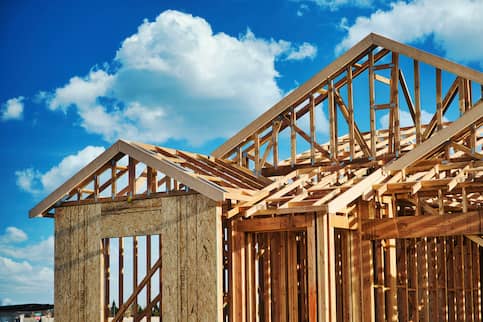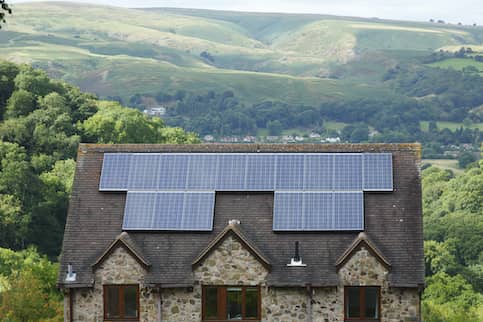Looking for a home? You might struggle to find the perfect one. That’s because the number of homes available across the country have been at lower-than-average levels for years now. This low housing inventory means that buyers must act quickly when they do find a home that fits their needs.
If they don’t, other buyers might snatch it up.
Navigating a market with low housing inventory can be challenging. By taking some simple steps – like getting preapproved for a mortgage and working with a real estate agent who knows the area– you can gain an advantage in your house hunt.
Take the first step to buy a home.
Quicken Loans® lets you get to house hunting sooner.
What Does Low Housing Inventory Mean?
In a housing market with low inventory, sellers typically charge more for homes while buyers have fewer choices when hunting for their new residences. This makes low inventory markets especially challenging for buyers and favorable to sellers.
Low housing inventory means that there aren’t as many homes for sale in markets as there usually are. The United States was in the middle of low-inventory housing market in mid-2022, with the National Association of REALTORs® (NAR) reporting that there were 1.16 million housing units for sale at the end of May of that year, down 4.1% from a year earlier.
The association said that unsold housing inventory sat at a supply of 2.6 months at the end of May at the current sales pace of housing.
A low housing inventory means that buyers will typically pay more for homes because the demand for those on the market tends to be higher. The Months Supply of Inventory, better known as MSI, is a numerical representation between the supply for homes and the demand for them. If MSI is less than 4 months, sellers gain the advantage in real estate transactions, and will ask for higher prices for their homes.
As long as housing inventory remains low, then, buyers can expect to pay more for homes and should also prepare to lose out on homes if they don’t make higher offers quickly enough.
See What You Qualify For
Buy A Home
Discover mortgage options that fit your unique financial needs.

Refinance
Refinance your mortgage to have more money for what matters.
Tap Into Equity
Use your home’s equity and unlock cash to achieve your goals.
What Can You Expect If You’re Entering The Housing Market?
Because the country is in a low housing inventory market, it’s little surprise that home prices are rising, so don’t be shocked if you end up spending more on a home today.
NAR reported that the median existing-home price for all housing types in the United States rose to $407,600 in May. That’s up 14.8% from the same month one year earlier, when the median price stood at $355,000.
The association says that May’s increase marks the 123rd consecutive month in which the median existing-home price increased on a year-over-year basis. This is the longest streak that the association has ever recorded.
Housing prices aren’t rising as quickly in all states, though. In a recent affordability report, NAR said that the most affordable states for all home types in April of 2022 were Iowa, Ohio, West Virginia, Kansas and Illinois. The least affordable were Idaho, Utah, California, Oregon and Washington.
Why Is The Housing Inventory So Low Right Now?
There are several reasons why housing inventory remains so low today.
Interest Rates Are Going Up
Mortgage interest rates have been low for a long time. In late July of 2021, the average interest rate on a 30-year, fixed-rate mortgage loan stood at just 2.78%, according to Freddie Mac. That is low and made mortgage loans less expensive. Because of this, more buyers could afford to purchase a home. This larger number of customers ate into the supply of available homes, lowering the inventory of residences for sale.
Mortgage interest rates, though, are now on the rise, with Freddie Mac reporting that the average rate on a 30-year fixed-rate mortgage hit 5.3% on July 7 of this year. That’s a big jump from last year and might chase some potential home buyers out of the housing market. This could cool down the market, which could mean a slow increase in the inventory of homes for sale.
Continuing Uncertainty Related To The Pandemic
The COVID-19 pandemic is still bringing uncertainty to the economy. At the same time, inflation means that the cost of everything from gas to groceries continues to rise. This combination is making many would-be home buyers nervous.
Then there are today’s high housing prices. Many homeowners could sell their current residences for top dollar. The challenge, though, is that any home they would then go on to buy would also cost more, eating up most of the profits they’d make by selling. The low housing inventory also makes it more difficult for these potential sellers to find their dream home.
Because of this, many owners today are choosing to stay put, even if they could make a solid profit when selling.
Costs And Supply Chain Disruptions In New Construction
Home builders today are struggling to get their materials to job sites on time. Blame supply chain disruptions for this. Builders are also struggling to find enough labor to keep their job sites running. At the same time, the cost of both materials and labor continue to rise.
This combination has slowed the delivery of new homes across the United States, adding to the already low inventory of residential real estate for sale. The good news is that the supply of new homes available for sale is rebounding.
The Federal Reserve Bank of St. Louis reported that the supply of new-construction homes for sale in the United States hit 7.7 months in May of 2022. That’s up from a low of 3.3 months in August of 2020.
Ready to refinance?
See recommended refinance options and customize them to fit your budget.
Why Is There A Housing Shortage In The US?
What’s behind the lack of available housing in the United States? Not surprisingly, several factors have contributed to this shortage.
Competition Between Home Buyers And Investors
Investors have long considered residential real estate to be a safe harbor for their dollars. This is especially true when the overall economy is shaky. Today, then, the traditional buyers of single-family homes are not only competing with other buyers but with investors big and small.
Some investors are also buying large tracts of land and developing homes for renters. Homeowners lost many of their tax advantages relative to renters once the 2017 Tax Cuts And Jobs Act went into effect. This act significantly increased the standard tax deduction, which makes the mortgage interest deduction less valuable to homeowners.
It also capped the deduction for state and local taxes at $10,000. This is a negative for home buyers, especially in high-tax states where the property tax deduction was usually worth far more than $10,000.
With these advantages gone, many people who would otherwise buy a home are choosing instead to rent. Some investors have responded to this by building rental housing instead of more single-family homes.
The National Association of Home Builders (NAHB) has said that single-family built-for-rent homes still account for a small segment of the housing industry. But the fact that some investors are bringing rental homes to market instead of traditional single-family homes is just one more strain on buyers in low-inventory markets.
Chronic Shortages Of Skilled Labor
Developers are building fewer new homes, too, because they are struggling to find enough labor. Home builders have been dealing with this labor shortage since the start of the COVID-19 pandemic.
According to the NAHB, the number of open construction sector jobs averaged between 300,000 to 400,000 each month as of late 2021. Without enough skilled labor to build homes, developers have brought fewer new homes to the market.
Rising Material Costs
Builders are also faced with rising costs on the materials they use to build new homes. Everything from steel and insulation to concrete and lumber costs more today. The NAHB in March of last year said that higher lumber prices added more than $24,000 to the price of a new home.
It’s also difficult for builders to get these materials thanks to disruptions in the supply chain that have continued throughout the pandemic. These disruptions, along with and higher prices, have delayed the amount of new home construction that the market would typically see.
Legal And Bureaucratic Obstacles
Home builders must also face zoning rules and permit requirements when they build in communities across the United States. Depending on how strict these regulations are, it can be difficult for builders to add more housing stock to certain areas.
Other municipalities have environmental, historical and community character preservation concerns, requiring builders to follow rules in how they can alter the exteriors of buildings and limiting what types of properties can be built in certain neighborhoods. Again, this can make it difficult for builders to add new homes to these communities.
How Does Low Home Inventory Affect The Housing Market?
A market with low inventory places new stresses on buyers, mostly in the form of more expensive homes and less choice. This NAR report analyzes how affordable housing is in all 50 states. If you’re looking for a new home, it’s an important report to read.
Seller’s Markets
There are two main types of residential real estate markets: buyer’s markets, where buyers enjoy more choice and bargaining power, and seller’s markets, where sellers can set higher asking prices and buyers face competition and bidding wars for homes. When housing inventory is low, the real estate market will slip into a seller’s market.
Facing a seller’s market isn’t new for buyers. Most real estate markets across the nation for the last several years have been seller’s markets. Historically low mortgage interest rates have made borrowing money to pay for a home less expensive. This gave buyers the power to purchase more expensive homes, and often resulted in bidding wars for the best properties, something that raised the sales prices of homes across the country.
During the pandemic, many office employees worked remotely. This meant that they could flee the most expensive markets in the country and instead purchase in more affordable communities. This boosted the real estate sales in these otherwise overlooked areas, fueling rising prices here, too.
Homes Are More Expensive
The laws of supply and demand mean that housing prices will rise when there are fewer homes available. In a market with low inventory, demand for those homes that are on the market soars. Sellers can then raise their asking prices because buyers have fewer options.
Buyers Have Fewer Contractual Protections
Because competition for available home is higher, buyers might decide to waive contingencies, such as requiring a home inspection before completing a home sale, to win bidding wars. This is more likely in markets in which there aren’t enough homes for sale for the number of buyers.
Waiving these contingencies can hurt buyers. Say they skip the home inspection in an effort beat out other buyers. After living in the home, they might discover that its foundation is sinking. They are then responsible for paying the big dollars to fix that structural issue.
When Will The Housing Supply Catch Up With Demand?
When will the number of homes for sale catch up with the demand for them? That’s a difficult question to answer. Economic uncertainty, inflation, rising interest rates and supply chain problems make it difficult to predict when, or if, housing prices might cool in 2023 and available inventory will grow.
The Bottom Line
With so much uncertainty in the housing market, you need an advantage. Once you are armed with a preapproval letter, sellers will view you as a more attractive buyer. That edge could mean the difference between landing your dream home or watching another buyer snatch it up.
Take the first step to buy a home.
Quicken Loans® lets you get to house hunting sooner.

Dan Rafter
Dan Rafter has been writing about personal finance for more than 15 years. He's written for publications such as The Washington Post, Chicago Tribune and Wise Bread.












